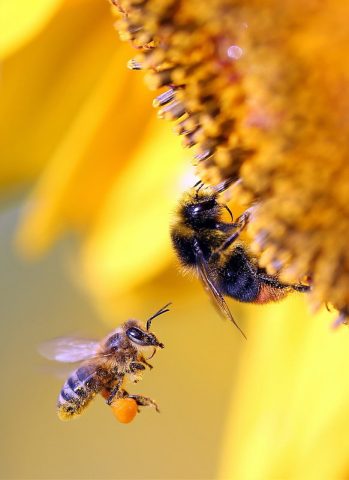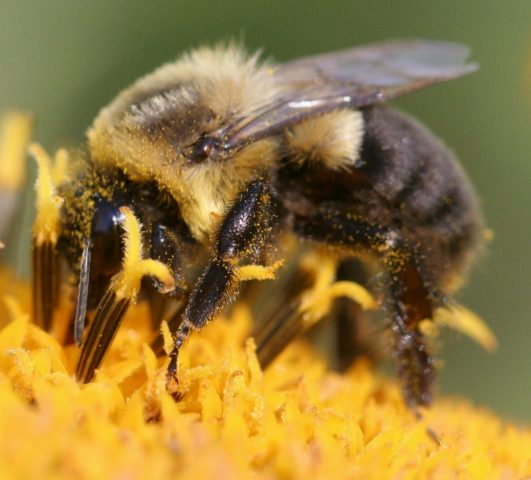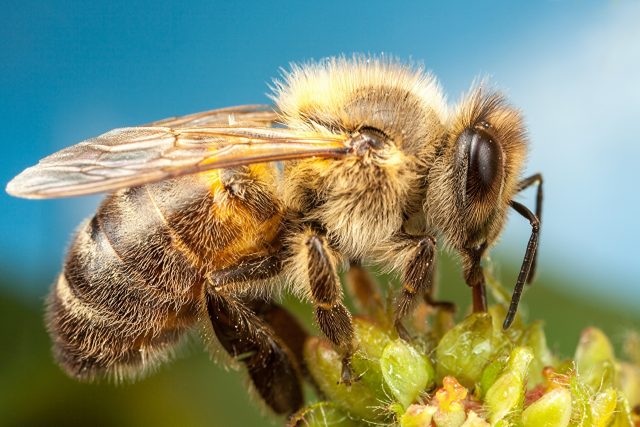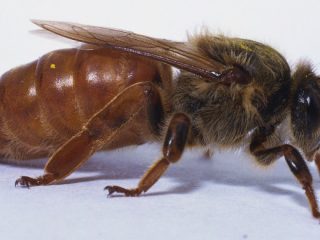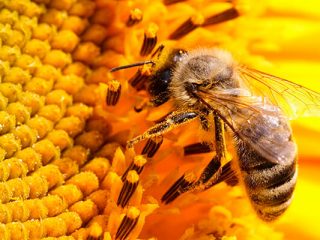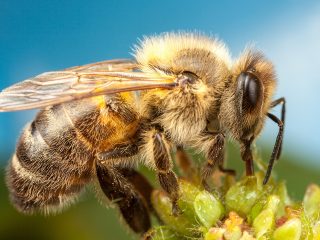Content
The difference between a bumblebee and a bee lies in the appearance and lifestyle. The bumblebee of the genus Hymenoptera is a close relative of the bee, belonging to the same species. The distribution area of insects is North America, Europe, Eurasia, almost all regions except Antarctica. The photo of a bumblebee (Bombus pascuorum) and a bee (Apis mellifera) clearly shows their visual differences.
What is the difference between a bumblebee and a bee
Of the representatives of the species, bumblebees are the most cold-resistant, they are able to raise the temperature of the body to 400 C, thanks to the rapid contraction of the pectoral muscles. This feature contributes to the spread of insects in colder regions. Early in the morning, even before sunrise, when the air has not warmed up enough, the bumblebee, unlike the bee, is able to start collecting nectar.
In bee colonies, there is a strict hierarchy and distribution of labor. Males are larger than females, apart from reproductive, they do not perform other functions in the hive. The drones have no sting. They are driven out of the hive before wintering. Unlike the bumblebee, the bees always return to the hive after flying around, and the bumblebees may not return to the nest, the connection between representatives of the same family is unstable.
The difference between insects in the behavior of queens: a young bee can fly out of the hive and take away a swarm of young individuals; bumblebee leaves only in spring to select a masonry site.
In bees, not only females but also drones emerge from a clutch of eggs, regardless of whether the eggs are fertilized or not. The task of the bumblebee uterus is reproduction. There are nurse bees in the Apis mellifera family, unlike them, in bumblebees, this role is played by males.
The difference between bees and bumblebees lies in the way the honeycombs are structured, in the former they have the same volume and are made strictly along the line. In bumblebees, the arrangement of honeycombs is chaotic, of different sizes. Closed in the form of a cone with honey, bees have a flat surface. There is also a difference in the building material:
- Apis mellifera has only wax, propolis is used for gluing;
- large insects build a honeycomb of wax and moss; propolis is not present.
Unlike bees, bumblebees are not aggressive. Only females are equipped with a stinger; in males, genitals with a chitinous covering are located at the end of the abdomen. Females rarely sting, in case of a serious threat to them. The bites of one individual bumblebee can be numerous, the bee dies after being bitten, this is due to the structure of the sting. Bumblebee venom is less toxic than bees, but more allergenic. Unlike the queen bee, the bumblebee has a sting and it is possible to use it.
The development time of the bee differs from that of the bumblebee by about one week. The bee has a 21-day cycle: an egg, a larva, a prepupa, a pupa, an adult. The bumblebee does not have a prepupal stage; it takes 14 days to develop to the state of an imago. A queen bee lays up to 130 thousand eggs per season, bumblebee only 400 pieces. The density of the bee colony is about 11,500 individuals, bumblebees in the nest no more than 300.
Summary table of distinctive characteristics between representatives of bees:
Characteristics | Bee | Bumblebee |
The size | up to 1.8 cm | 3.5 cm |
Coloration | dark yellow with brown stripes | bright yellow with black spots, black |
Hierarchy | strict | communication between individuals is unstable |
Life cycle | from 1 month to 1 year | 180 days |
Habitat | hollow tree (in the wild) | earthen holes, between stones |
Sting | only females are supplied, they die after being bitten | females are able to sting repeatedly |
Behavior | aggressive | calm |
Construction of honeycombs | symmetrical wax and propolis | disordered wax and moss |
Family size | up to 12 thousand | no more than 300 |
Wintering
| all bees hibernate except for drones | only young queens |
Honey collection | active, for winter storage | honey goes to feed the offspring, stocks are not made |
Comparison of insects
Insects belong to the same species, bees differ from the bumblebee radically. Not only in appearance and body structure, but also in habitat.
In appearance
Visual differences:
- The color of bumblebees is more varied than that of bees, this is due to thermoregulation and mimicry. The main species are bright yellow with black chaotic fragments, stripes are possible. Black bumblebees are less common. The entire surface, except for the eyes, is covered with thick, long hair.
- In contrast to the bumblebee, the color of the bee is dark yellow with pronounced brown stripes along the abdomen. The main background can change depending on the type to darker or lighter, the presence of stripes is constant. The pile is short, poorly visible on the upper part of the abdomen.
- Unlike a bee, a bumblebee has a larger body size. Females reach 3 cm, males - 2.5 cm. The abdomen of the insect is rounded without upward or downward concavity. Females are equipped with a smooth, notchless sting, which is pulled back after being bitten. The poison is non-toxic.
- The bee grows within 1.8 cm (depending on the species), the drones are larger than the worker bees. The abdomen is flat, oval, elongated, concave downward, at the end of the female there is a sting. The sting is serrated, after the bite the insect cannot remove it, it remains in the victim, and the bee dies.
- The structure of the head in insects is similar, the differences are insignificant.
- The structure of the wings is the same, the amplitude of movement is circular. Due to the well-developed pectoral muscles of the bumblebee, the movement of the wings is carried out more often than that of a bee, therefore bumblebees fly much faster.
Habitat
Bombus pascuorum tolerates low temperatures well due to its self-heating ability. The area in the Russian Federation spread to Chukotka and Siberia. The hot climate is not suitable for insects; bumblebees are practically not found in Australia. This feature differs the bumblebee from the bee. The bee, on the other hand, prefers to settle in regions with a warm climate. Australia, unlike Bombus pascuorum, is home to a large number of insect species.
Lifestyle Difference:
- Both representatives of bee flowers feed on nectar, bumblebees do not give special preference to a particular type of plant, except for clover, they spend the whole day on food. They return to the nest for a short time to feed the queen and bring nectar to brood.
- Bees spend less time on their own nutrition, their task is to procure raw materials for honey.
- Bumblebees settle their nests close to the ground in a layer of last year's leaves, in holes of small rodents, less often in nests abandoned by birds, among stones. Bees - in tree hollows, between branches, less often in dwelling attics or mountain crevices. Insects do not build a nest low to the ground. The difference between the interior arrangement lies in the location of the honeycomb and the building material used.
Quality and chemical composition of honey
Both types of insects produce honey. The bumblebee product differs from the bee in the concentration of active substances and consistency. Bee honey is much thicker, insects store it for the winter, the volume from a family is much larger, so people use bees to produce bee products. Chemical composition:
- amino acids;
- vitamin compounds;
- glucose;
- minerals.
Due to the higher water content, bumblebee honey has a liquid structure. The amount per family is minimal. It does not have a long shelf life. At positive temperatures, the fermentation process begins. Bumblebees collect it from a larger variety of plants, so the concentration of the composition is much higher, in contrast to the bee. Composition:
- carbohydrates (fructose);
- proteins;
- amino acids;
- potassium;
- iron;
- zinc;
- copper;
- a set of vitamins.
Wintering
Apis mellifera live within a year, all representatives of the hive winter (except for drones). Of the old individuals, few remain, most of them die during the honey harvesting season. Only working individuals are engaged in harvesting honey for the winter. The specially designated honeycomb is completely filled with honey, it should be enough until spring. After removing the drones from the nest, the bees clean the wintering place, with the help of propolis, all the cracks and the passage for the flight are sealed.
Unlike bees, honey is not harvested from Bombus pascuorum. They collect it to feed their offspring. In the process of honey collection, males and female workers take part. By winter, all adults, except for the queens, die. Of the bumblebee females, only young fertilized ones overwinter. They fall into suspended animation, do not feed in winter. Since spring, the life cycle continues.
Conclusion
The difference between a bumblebee and a bee lies in the appearance, habitat, in the distribution of responsibilities within the family, in the length of the life cycle, in the quality and chemical composition of honey. Insect breeding has a different functional direction. Large representatives are suitable only for pollination purposes. Bees are used to produce honey, pollination is a minor task.
